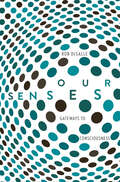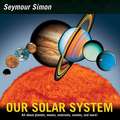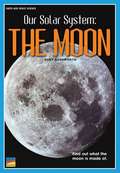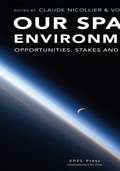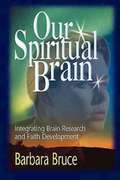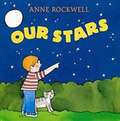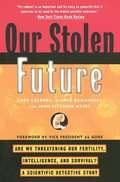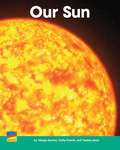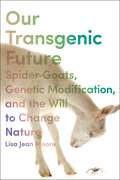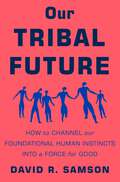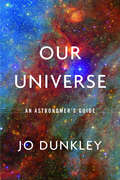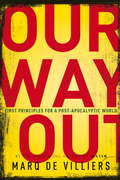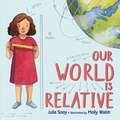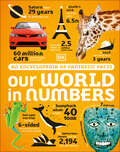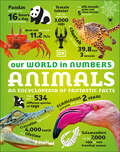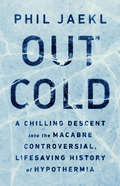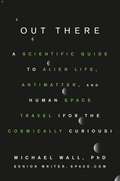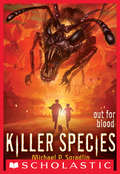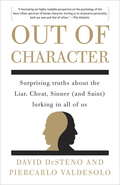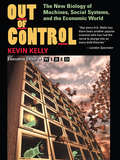- Table View
- List View
Our Senses: Gateways to Consciousness
by Rob DeSalle“An animated introduction to the neuroscience of sensory perception” informed by the latest research on topics from music to brain injuries to synesthesia (Kirkus Reviews).In recent years neuroscience has uncovered a wealth of new information about our senses and how they serve as our gateway to the world. This splendidly accessible book explores the most intriguing findings of this research. With infectious enthusiasm, Rob DeSalle illuminates not only how we see, hear, smell, touch, taste, maintain balance, feel pain, and rely on other less familiar senses, but also how these senses shape our perception of the world aesthetically, artistically, and musically.DeSalle first examines the question of how perception and consciousness are formed in the brain, setting human senses in an evolutionary context. He then investigates such varied themes as supersenses and diminished senses, synesthesia and other cross-sensory phenomena, hemispheric specialization, diseases, anomalies induced by brain injuries, and hallucinations. Focusing on what is revealed about our senses through the extraordinary, he provides unparalleled insights into the unique wonders of the human brain.“In the laboratory sensory science is serious business. But in the capable hands of Rob DeSalle it becomes fun and compelling for the general reader, and is made all the more accessible by Patricia Wynne’s delightful illustrations.” —Ian Tattersall, author of The Strange Case of the Rickety Cossack and Other Cautionary Tales from Human Evolution
Our Solar System
by Seymour SimonBorn almost 5 billion years ago at the edge of the Milky Way galaxy, our Solar System is a place filled with mystery and wonder. In the last fifty years, we have learned more than ever about the farthest reaches of our world. With dramatic full-color photographs and spacecraft images, Our Solar System takes young readers on a fascinating tour of the sun, the eight planets, and their moons, plus asteroids, comets, and meteoroids. Award-winning science writer Seymour Simon has teamed up with the Smithsonian Institution on this new, updated edition of his much admired book about the vast and mystifying part of the universe that we live in.
Our Solar System: An Exploration of Planets, Moons, Asteroids, and Other Mysteries of Space
by Lisa ReichleySuit up for an expedition into the mysteries of our amazing solar system and beyondThe universe is huge. With more than 100 billion galaxies and billions of orbiting astronomical bodies, there's so much to learn. Rocket through the cosmos, and discover everything there is to know about our exciting and mysterious solar system!From the bright, burning sun to the icy Kuiper Belt, this easy reference guide is packed with fascinating facts about the terrestrial planets, gas giants, and dwarf planets, plus other orbiting astronomical bodies such as satellites and asteroids. Then, explore further into the unknown as you learn about mysterious bodies such as comets and clouds, and how much more we have to discover!Our Solar System includes:Fact-filled flight—Learn all about the astronomical bodies in our solar system with profiles covering size, distance from the sun, the length of each year, and more.Tiny but mighty—Enjoy a detailed look at the smaller bodies in our solar system such as dwarf planets, satellites, asteroids, and the objects in the Kuiper Belt and the Oort cloud.Out-of-this-world photos—Get up close and personal with real, vibrant photos of our very special solar system.Rocket through the cosmos and explore the many mysteries of our magnificent solar system!
Our Solar System: Revised Edition (Seymour Simon Science Ser.)
by Seymour SimonJoin award-winning science writer Seymour Simon in this completely updated edition of Our Solar System, as he takes young readers on a fascinating tour through space! With beautiful full-color photographs and spacecraft images, including many taken by the Mars rovers and Hubble Space Telescope, this nonfiction picture book teaches young readers all about the solar system, including the sun, the eight planets, and their moons. Covering all the latest discoveries in space, young astronomers will be over the moon about the fun facts, fascinating science, and incredible photographs. A must-have for every child interested in outer space! This book includes an author's note, a glossary, an index, and further reading suggestions. An excellent choice for classrooms and homeschooling, Our Solar System supports the Common Core State Standards.Check out these other Seymour Simon books about the universe and space:Comets, Meteors, and AsteroidsDestination: JupiterDestination: MarsDestination: SpaceExoplanetsGalaxiesStarsThe SunThe Universe
Our Solar System: The Moon
by Pam Hirschfeld Garry RushworthFind out about where the moon came from and find out about its properties.
Our Space Environment, Opportunities, Stakes and Dangers
by Roger-Maurice Bonnet Claude NicollierThe space surrounding our planet is full of opportunities and resources. Ranging from a hundred to a few thousand kilometers around Earth, our space-neighborhood offers an excellent vantage point to the universe, and a great opportunity to push the frontiers of science and knowledge. Manned missions advance research on human biology, health, and li
Our Spiritual Brain: Integrating Brain Research and Faith Development
by Barbara BruceBrain research is about making discoveries. It is about learning how this most amazing organism works and how it influences every aspect of your life. As religious educators, you need to know how the brain functions and how to translate that information into better, more usable lessons to help students continue, with depth and purpose, on their journey of faith. The first section of this book is a brief background of the brain research that is fascinating so many people in so many fields today. The second section is about learning, particularly brain-based learning. The third section is divided into twelve segments. Each segment is a practical application to Christian education based on the findings in brain research. The fourth section will help you to take your learning about the brain into new areas of discovery.
Our Stars
by Anne RockwellScientists use telescopes and satellites to study the stars. But even though they're far away, stars are part of your world, too! Just lift up your eyes to see. Anne Rockwell explains the universe with bright pictures and simple text in a book that will delight any curious child's mind!
Our Stolen Future: Are We Threatening Our Fertility, Intelligence, and Survival? A Scientific Detective Story
by Theo Colborn Dianne Dumanoski John Peterson MyersOver thirty years ago, Rachel Carson's Silent Spring first warned that man-made chemicals were taking a deadly toll on birds and wildlife. Only now, however, are we recognizing the full consequences of this insidious threat, which is derailing sexual development and reproduction-not only in a host of animal populations but, it appears, in humans as well. Written by two leading environmental scientists and an award-winning environmental journalist, Our Stolen Future has already become one of the most controversial and talked-about books of the decade. Picking up where Silent Spring left off, this groundbreaking work gives an utterly gripping account that traces birth defects, sexual abnormalities, and reproductive failures in wildlife to their source-synthetic chemicals that mimic natural hormones, upsetting normal reproductive and developmental processes. And humans appear far from immune to the effects of these "hormone impostors." Male sperm counts have dropped as much as 50 percent in recent decades, while women have suffered a dramatic rise in hormone-related cancers, endometriosis, and other disorders. By threatening the ability to reproduce, these chemicals may be invisibly undermining the human future. Piecing together the clues, the authors detail how these industrial pollutants have spread with ease through the web of life from the equator to the poles, and explore what we can and must do to combat this invasion. Timely, urgent, and scrupulously reported, this riveting story of scientific detection will have a major impact on public debate for decades to come. It is indispensable for those concerned about the profound human impact on the environment, the well-being of our children, and the survival of our species.
Our Sun
by Tammy Jones Margie Burton Cathy French Kathleen Kuchera Martin SeddonThis book is about the properties of the sun.
Our Transgenic Future: Spider Goats, Genetic Modification, and the Will to Change Nature
by Lisa Jean MooreHow scientific advances in genetic modification will fundamentally change the natural worldThe process of manipulating the genetic material of one animal to include the DNA of another creates a new transgenic organism. Several animals, notably goats, mice, sheep, and cattle are now genetically modified in this way. In Our Transgenic Future, Lisa Jean Moore wonders what such scientific advances portend. Will the natural world become so modified that it ceases to exist? After turning species into hybrids, can we ever get back to the original, or are they forever lost? Does genetic manipulation make better lives possible, and if so, for whom?Moore centers the story on goats that have been engineered by the US military and civilian scientists using the DNA of spiders. The goat’s milk contains a spider-silk protein fiber; it can be spun into ultra-strong fabric that can be used to manufacture lightweight military body armor. Researchers also hope the transgenically produced spider silk will revolutionize medicine with biocompatible medical inserts such as prosthetics and bandages. Based on in-depth research with spiders in Florida and transgenic goats in Utah, Our Transgenic Future focuses on how these spidergoats came into existence, the researchers who maintain them, the funders who have made their lives possible, and how they fit into the larger science of transgenics and synthetics. This book is a fascinating story about the possibilities of science and the likely futures that may come.
Our Tribal Future: How to Channel Our Foundational Human Instincts into a Force for Good
by David R. SamsonAn astounding and inspiring look at the science behind tribalism, and how we can learn to harness it to improve the world around us.What do you think of when you hear the word “tribalism?” For many, it conjures images of bigotry, xenophobia, and sectarian violence. Others may envision their own tribe: family, friends, and the bonds of loyalty that keep them together. Tribalism is one of the most complex and ancient evolutionary forces; it gave us the capacity for cooperation and competition, and allowed us to navigate increasingly complex social landscapes. It is so powerful that it can predict our behavior even better than race, class, gender, or religion. But in our vast modern world, has this blessing become a curse?Our Tribal Future explores a central paradox of our species: how altruism, community, kindness, and genocide are all driven by the same core adaptation. Evolutionary anthropologist David R. Samson engages with cutting-edge science and philosophy, as well as his own field research with small-scale societies and wild chimpanzees, to explain the science, ethics, and history of tribalism in compelling and accessible terms.This bold and brilliant book reveals provocative truths about our nature. Readers will discover that tribalism cannot, and should not, be eliminated entirely—to do so would be to destroy what makes us human. But is it possible to channel the best of this instinct to enrich our lives while containing the worst of its dangers?
Our Universe: An Astromer's Guide
by Jo DunkleyJo Dunkley combines her expertise as an astrophysicist with her talents as a writer and teacher to present an elegant introduction to the structure, history, and enduring mysteries of the universe. Among the cutting-edge phenomena discussed are the accelerating expansion of the universe and the possibility that our universe is only one of many.
Our War on Ourselves
by Willem H. VanderburgOur approach to knowing and doing is based on delegating physical phenomena to physicists, biological phenomena to biologists, social phenomena to sociologists, economic phenomena to economists, and so on. This approach to knowledge and practice works very well when one category of phenomena dominates (as in mechanical and technical systems), but does not work when many categories of phenomena make significant contributions (as in the biological and cultural spheres). As a result, our civilization succeeds in its scientific and technical endeavours yet fails in dealing with communities and ecosystems.Following his groundbreaking Labyrinth of Technology and Living in the Labyrinth of Technology, Willem H. Vanderburg's Our War on Ourselves explores the type of war we have unleashed on our lives by emphasizing discipline-based processes. The work also illuminates how we can achieve a more balanced, livable, and sustainable future by combining technical and cultural perspectives in our educational and institutional settings.
Our Way Out: Principles for a Post-apocalyptic World
by Marq De VilliersGlobal warming, energy shortages, overpopulation -- it's no wonder that as a society, we're in an apocalyptic mood. Out of an endless stream of gloomy prognoses for humanity's future, we have emerged with little inspiration and few concrete ideas for change. Our Way Out is the first time that our most urgent global challenges have been treated as aspects of a single, larger crisis -- and the first to acknowledge that while crises reinforce each other, solutions enable each other. The transformation to sustainability is already happening, in many small ways, in many parts of the world. Our Way Out shows us how we can scale up these efforts to create meaningful and lasting change.This is not a book on climate change, energy, or any other single issue -- it is the story of how within the solutions to the global crises we face, lie the seeds of something greater. It is a handbook for immense and exciting worldwide change. And, not least of all, it offers us robust hope that we can make things better.From the Hardcover edition.
Our World (Amadera Prthibi) class 7 - West Bengal Board: আমাদের পৃথিবী সপ্তম শ্রেণি
by West Bengal Board of Secondary Education"আমাদের পৃথিবী" একটি সপ্তম শ্রেণির ভূগোল এবং পরিবেশ শিক্ষার পাঠ্যপুস্তক যা পশ্চিমবঙ্গ মধ্যশিক্ষা পর্ষদ দ্বারা প্রকাশিত। এই বইটি সহজ এবং প্রাঞ্জল ভাষায় পরিবেশ এবং মানবজীবনের মধ্যে সম্পর্কের নানা দিক তুলে ধরেছে। বইটি জাতীয় পাঠক্রমের রূপরেখা ২০০৫ এবং শিক্ষার অধিকার আইন ২০০৯-এর নির্দেশিকা মেনে তৈরি করা হয়েছে। বিভিন্ন চিত্র, সারণি, এবং মানচিত্রের মাধ্যমে শিক্ষার্থীদের জন্য ভূগোলের মৌলিক ধারণাগুলোকে সহজবোধ্য এবং আকর্ষণীয় করে তোলার চেষ্টা করা হয়েছে। এতে পৃথিবীর গতি, ঋতু পরিবর্তন, বায়ুচাপ, ভূমিরূপ, নদী, শিলা, এবং দূষণের প্রভাব সহ এশিয়া, আফ্রিকা ও ইউরোপ মহাদেশের ভূগোল অন্তর্ভুক্ত করা হয়েছে। বইটির লক্ষ্য শিক্ষার্থীদের হাতে-কলমে শিক্ষা কার্যক্রমের মাধ্যমে জ্ঞান লাভে সহায়তা করা।
Our World Is Relative
by Julia SooyA fun and engaging picture book from author Julia Sooy and illustrator Molly Walsh explaining Einstein's theory of relativity.Size, speed, weight, direction, distanceWe think of space and time as fixed and measurable.But these measurements—our experience of space and time—they are relative.Our world is relative.With simple, engaging text and vibrant art imbued with light and movement, Our World Is Relative offers a child's-eye view of time, space, and the vast role that relativity plays in comprehending our world. It's an introduction to Albert Einstein's theory of relativity, perfect for any curious young scientist.Longlisted for the American Association for the Advancement of Science/ Subaru Children's Science Picture Book Award
Our World in Numbers (DK Oour World in Numbers)
by DKZillions of fun figures at your fingertips!Are you eager to know all the most incredible facts and stats? Would you like to number-crunch your way around the wonders of our world?Arm yourself with nuggets of number knowledge and fantastic figures with this data-filled book that explores everything in our world from space to sports and animals to art. How long does it take to put on a spacesuit? How many times does a sloth poop in a week? How many stone blocks are there in the Great Pyramid at Giza? What percentage of your brain do you really use? With intriguing fact-bites and colorful data graphics, Our World in Numbers takes you on a remarkable adventure by numbers, telling you everything you could possibly need to know--and more!
Our World in Numbers Animals: An Encyclopedia of Fantastic Facts (DK Oour World in Numbers)
by DKLearn about everything in the animal kingdom with this book of extraordinary figures and number-based facts for children aged 9-12!Put the fun back into learning and take children on a number-crunching journey around the animal kingdom. From colossal mammals to tiny insects and everything in between, learn all about your favorite animals with more than 1,000 weird and wonderful numbers.Our World in Numbers: Animals will have you impressing your family and friends like never before with mind-blowing facts and stats on a vast range of different animal species. Children aged 9-12 will number-crunch their way around the animal kingdom, discovering everything from the age of the world&’s oldest animal and which bird has the most feathers, to which snake has the longest fangs and how long a tiger sleeps in a day.This animal book of fantastic figures offers:- More than 1,000 astonishing animal facts for children aged 9-12.- Different topics divided by 5 chapters, invertebrates, fish, amphibians and reptile, birds and mammals.- Eye-catching double page features, including vibrant photographs and graphics for every topic.- Fun and surprising information on more than 80 topics to engage children in the world around them.This data-packed adventure through the animal world is filled with everything you&’ve ever wanted to know about your favourite animals, with full-page photographs and fun, colorful images, wacky animal fact-bites and funky figures to become an animal expert!
Out Cold: A Chilling Descent into the Macabre, Controversial, Lifesaving History of Hypothermia
by Phil Jaekl&“A fascinating look into the strange and sometimes unbelievable history of hypothermic medicine. Jaekl weaves together a story that is part history lesson and part science thriller. This is truly a must-read for any fan of science and science fiction!&” —Douglas Talk, MD/MPH, chief medical consultant, SpaceWorks Inc., Human Torpor Project The meaning of the word &“hypothermia&” has Greek origins and roughly translates to &“less heat.&” Its symptoms can be deadly—shivering, followed by confusion, irrationality, and even the illusion of feeling hot. But hypothermia has another side—it can be therapeutic. In Out Cold, science writer Phil Jaekl chronicles the underappreciated story of human innovation with cold, from Ancient Egypt, where it was used to treat skin irritations, to eighteenth-century London, where scientists used it in their first explorations of suspended animation. Throughout history, physicians have used cold to innovate life extension, enable distant space missions, and explore consciousness. Hypothermia may still conjure macabre images, like the bodies littering Mt. Everest and disembodied heads in cryo-freezers, but the reality is that modern science has invented numerous new life-saving cooling techniques based on what we&’ve learned over the centuries. And Out Cold reveals a surprisingly warm future for this chilling state.
Out There: A Scientific Guide to Alien Life, Antimatter, and Human Space Travel (For the Cosmically Curious)
by Michael WallWe've all asked ourselves the question. It's impossible to look up at the stars and NOT think about it: Are we alone in the universe? Books, movies and television shows proliferate that attempt to answer this question and explore it. <P><P>In OUT THERE Space.com senior writer Dr. Michael Wall treats that question as merely the beginning, touching off a wild ride of exploration into the final frontier. He considers, for instance, the myriad of questions that would arise once we do discover life beyond Earth (an eventuality which, top NASA officials told Wall, is only drawing closer). <P><P>What would the first aliens we meet look like? Would they be little green men or mere microbes? Would they be found on a planet in our own solar system or orbiting a star far, far away? Would they intend to harm us, and if so, how might they do it? And might they already have visited? <P><P>OUT THERE is arranged in a simple question-and-answer format. The answers are delivered in Dr. Wall's informal but informative style, which mixes in a healthy dose of humor and pop culture to make big ideas easier to swallow. <P><P>Dr. Wall covers questions far beyond alien life, venturing into astronomy, physics, and the practical realities of what long-term life might be like for we mere humans in outer space, such as the idea of lunar colonies, and even economic implications. Dr. Wall also shares the insights of some of the leading lights in space exploration today, and shows how the next space age might be brighter than ever.
Out for Blood: Out for Blood (Killer Species #3)
by Michael P. SpradlinThe action-packed series by Michael P. Spradlin returns. Each book covers a genetically engineered superpredator wreacking havoc on the environment.Dr. Catalyst has finally come unhinged. Twice the crazed scientist has released his super predators into the wild to combat invasive species, and twice Emmet Doyle and his best friend Calvin Geaux have exploded his efforts. Now he's out for something more than just snakes and fish. Dr. Catalyst wants revenge.It's a quiet night when Emmet takes his dog, Apollo, out for a walk in the backyard. Until the noise begins. Part batlike screech, part insect buzz -- it seems to be coming from the roof. Suddenly the sky is full of dark, beating shapes, and they're all headed straight for Emmet. Dr. Catalyst's newest creations are hungry, and only one thing will satisfy them. Blood.
Out of Character
by Piercarlo Valdesolo David DestenoHave you ever wondered why a trumpeter of family values would suddenly turn around and cheat on his wife? Why jealousy would send an otherwise level-headed person into a violent rage? What could drive a person to blow a family fortune at the blackjack tables? Or have you ever pondered what might make Mr. Right leave his beloved at the altar, why hypocrisy seems to be rampant, or even why, every once in awhile, even you are secretly tempted, to lie, cheat, or steal (or, conversely, help someone you never even met)? This book answers these questions and more, and in doing so, turns the prevailing wisdom about who we are upside down. Our character, argue psychologists DeSteno and Valdesolo, isn't a stable set of traits, but rather a shifting state that is subject to the constant push and pull of hidden mechanisms in our mind. And it's the battle between these dueling psychological forces that determine how we act at any given point in time. Drawing on the surprising results of the clever experiments concocted in their own laboratory, DeSteno and Valdesolo shed new scientific light on so many of the puzzling behaviors that regularly grace the headlines. For example, you'll learn: * Why Tiger Woods just couldn't resist the allure of his mistresses even though he had a picture-perfect family at home. And why no one, including those who knew him best, ever saw it coming. * Why even the shrewdest of investors can be tempted to gamble their fortunes away (and why risky financial behavior is driven by the same mechanisms that compel us to root for the underdog in sports). * Why Eliot Spitzer, who made a career of crusading against prostitution, turned out to be one of the most famous johns of all time. * Why Mel Gibson, a noted philanthropist and devout Catholic, has been repeatedly caught spewing racist rants, even though close friends say he doesn't have a racist bone in his body. * And why any of us is capable of doing the same, whether we believe it or not!A surprising look at the hidden forces driving the saint and sinner lurking in us all, Out of Character reveals why human behavior is so much more unpredictable than we ever realized. From the Hardcover edition.
Out of Control: The New Biology of Machines, Social Systems and the Economic World
by Kevin KellyGood analysis of emerging understanding of biological and non-biological systems composed of thousands or millions of agents.
